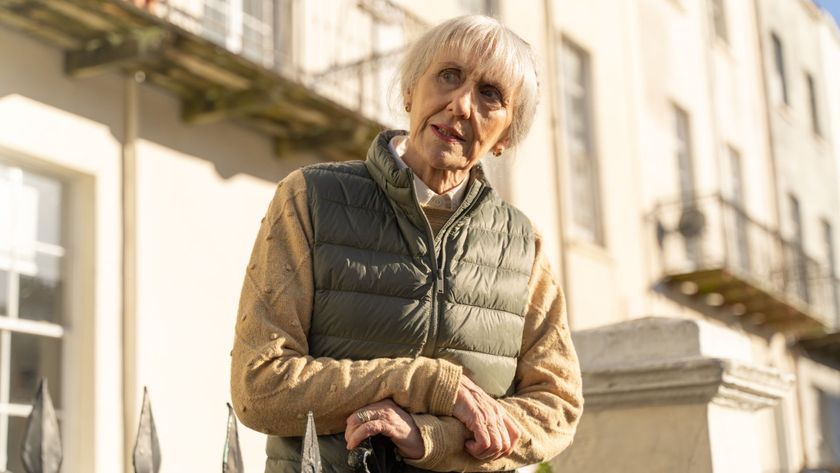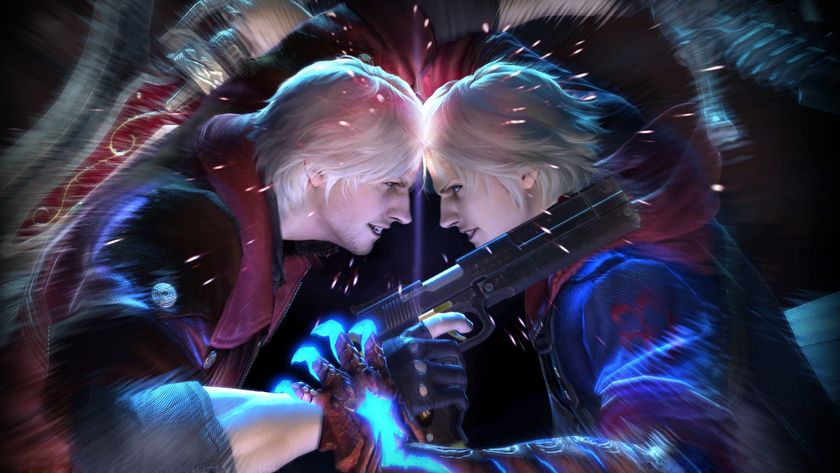First up, Rob Mayor of Millennium FX, the prosthetics specialists who've made a menagerie of monsters for Doctor Who...
SFX: The werewolf transformations don't take all that long on screen, but there must be much more work that goes into them. How long does the job take you?
Because they had to go through three distinct looks, the actors had to be in exceptionally early, it would take a whole day to shoot one transformation scene. Sometimes taking the make-up off takes as long as it does to glue on, but the guys were really patient.
SFX: How much of the transformation is performed by the actor, and how much is dummies or stunt doubles?
We had a life cast of Russell Tovey’s [the now deceased George] head. There was a rig on the inside that would push his muzzle out so it makes him look like his nose and chin are extending. Then they would cut away to the back or foot, then cut back to his stage two dummy rig which was more wolf-like but carries on where the other rig left off. The next jump would then be to the full werewolf suit, which was played by a guy called Paul Kasey. Adding all this together it made more of a continuous flow of transformation.
SFX: How have the transformations changed over the course of the four series of Being Human ?
From the earliest series we had a extending nail rig, which was operated by cable that would glue to the back of the hand, then you’d shoot the palm and see the nails extend from their fingertips. We had a chest appliance for Russell that had a rig-shaped bladder underneath, an appliance that went over his entire chest. Underneath were balloons that were custom made so that when they inflated they were the shape of ribs.
We found the best and safest way to inflate these rigs was colostomy bags because they’ve got this great one-way valve system. Obviously we’d buy them new from a medical supplier! You could inflate them one end so they would stay inflated and there was a valve on the other end and we would put some tube connectors on, so you get the impression of the ribs poking out.
Nina had a stage one rig built for her as well that had the burn on her chest, that was all incorporated as well. We built a full chest appliance for her as well, so her ribs would extend down to her waist all the way up to her neck.
It can all be mixed and matched around so that they didn’t end up repeating themselves every time they did a transformation scene.
Sign up to the SFX Newsletter
Get sneak previews, exclusive competitions and details of special events each month!
SFX: Baby Eve has werewolf DNA. Did you ever think about what you’d do if it turned out she could transform?
There were discussions about the logistics of transforming a werewolf baby, we’ll see if they decide to do that or not, but it would be a cool thing to do. It would have to be a complete fake baby. I mean there’s laws against gluing appliances on babies, and rightly so!
SFX: Did any previous werewolf transformations in movies and TV influence your work on Being Human ?
I think everyone as a prosthetic artist was blown away by the American Werewolf In London transformation. They didn’t hide anything at all. That has been an influence for nearly all werewolf transformations since then. We tried not to copy that, but I think you can’t but help to be influenced by work you admire. When we were first in the meetings of Being Human , from the production side that certainly came up as a key reference point. Also the transformations for The Howling . The Howling transformations were darker and more disturbing, playing a lot on what you didn’t see. We tried to strike up a mix between the two.
Look over the page for our interview with make-up supremo Helen Tucker...
Make-up supremo Helen Tucker on her part of the werewolf equation...
SFX: How does the make-up department contribute to the werewolf transformations?
What you’re seeing on screen is in reverse of how we’ve actually shot it. We tend to work with Rob at Millennium FX schedule-wise because the main mask of the werewolf takes a phenomenal amount of time to put on, so we do the final transformation first and work backwards.
The actors come back to us, and Millennium take bits of the prosthetics off, and then we start adding bits on so they’ve still got the teeth, the eyes, the nails. We put the blood around the fingernails so the nails look almost as though they’re bursting out. Then we take those bits off to the point where they’re just beginning to transform. This is mostly to do with time, because if we started off doing our section all the crew would be waiting around for that final facial prosthetics to go on.
SFX: Are there any transformations that are purely make up, with no input from the prosthetics team?
When we did the forced transformation that George did in the final scene of episode one. We’d never actually seen a werewolf do a forced transformation, and with discussions with the director and with Russell Tovey we came to the conclusion that we wanted to do this ourselves. We decided to do a lopsided version so that only half his face started to transform, so we only put one contact lens in, we had facial hair starting, veins bursting across him, and we put the teeth in and a lot of blood coming out of his mouth. I swelled up one eye and shut it down completely using a silicone piece and put silicone around his ear to give that lopsided effect.
We wanted to make it look almost as if he’d had a stroke. We were trying to portray not only that he was turning and becoming this monster, but at the same time he was killing himself because of the pressure on all the organs.
SFX: What do you do to make the werewolves look authentic?
The one thing we really wanted to concentrate on this year was more lubrication, because we don’t want the viewer looking at these and thinking fluffy dog. The way around it was a lot more liquid and gunge, and placing it in the corners of the mouth and down in the hairline so it just begins to drip off them. What you want to do with the audience is give them the yuck factor.
SFX: Do you try to introduce a degree of individuality to each werewolf?
Every werewolf has had some sort of scarring. Like Leo, he had his scar across his chest, Michael’s [Tom] claw marks are down the back of his head, and Russell [George] had his markings too so we’ve always done that. And with all the full transformations that we’ve seen there’s always been two sets of teeth for different stages, made especially for the actor by a dentist.
SFX: So do you do all the wounds and injuries as well?
All of the injuries you see on Being Human are done purely by me and my team. Especially all the ripped out necks that we see, which are great fun to do, very messy. We ended up doing one on Alex – we had maggots crawling out of her prosthetics on her neck. I had to literally get fistfuls of maggots and pour them into this prosthetic on her neck. She was so brave, they were dropping into her bra and everywhere and they stank! We had tremendous fun doing that.
SFX: You work on Casualty as well. How has that influenced your work on Being Human ?
Casualty has been a phenomenally good background for me because having been in medical meetings for the last 13-14 years, I’m certainly fully aware of what something should look like. We do blood and guts all the time but more in a reality sense of medical drama. I’ve looked at so many dead bodies, so many operations, burns and ripped open legs, car crash victims, it has given me a tremendous insight into how far we can take something.
SFX: So you like getting a strong reaction from your injuries?
I remember once I had to do a demonstration at my daughter’s school fair, and I took a whole load of legs and arms and bits in, thinking they were going to love it. Then as soon as I put an operating green around these limbs they started fainting and leaving the classroom in great haste. I suddenly realised, as soon as you wrap it up with operating green or put a knife near it and blood on it, it comes alive. I think with Being Human that’s what we’ve tried to do, we’ve tried to bring it really alive and really to the forefront and it makes people think.
SFX: What about the vampires. How do you do the eyes and teeth?
The vampires are far more simple. The werewolves have contact lenses, but on the vampires they CGI the blackness onto them. We put the teeth in, we’ve been using the same teeth now I think for all four series. They take some time moulding them to the end of each tooth, but once they’re in they stay in for quite some time.
Sometimes people criticise us for not making them look big enough, but less is more. If you do too much it starts to look comical, so I’ve always tried to underplay stuff a little bit. They all have their own individual sets labelled up for them so we can use them over and over again.
For us the harder work comes from the damage that vampires do. They seem to want to rip out an awful lot of throats. I love doing that, that’s such fun! There’s a lot of wanting to drain off the blood, so we had great fun planting in pipes into the prosthetics that are in the neck. Which is sometimes quite tricky because you’re trying to get these pipes threaded through and then you’ve got to de-rig the actor when they want to go to the loo or want to go outside for a cigarette. It’s a bit of a mechanical effort that goes in from all departments.
Helena Cole
The final episode of Being Human series four airs on BBC Three at 9pm on Sunday night.
Read our Being Human interview with script editor Laura Cotton.
Read our Being Human series four reviews .
Read our interview with Damien Molony and our interview with Toby Whithouse about “Hold The Front Page” .
SFX Magazine is the world's number one sci-fi, fantasy, and horror magazine published by Future PLC. Established in 1995, SFX Magazine prides itself on writing for its fans, welcoming geeks, collectors, and aficionados into its readership for over 25 years. Covering films, TV shows, books, comics, games, merch, and more, SFX Magazine is published every month. If you love it, chances are we do too and you'll find it in SFX.













